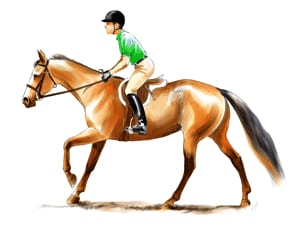Strength and balance work together to help riders relax and communicate with their horse for the best ride possible, whether it’s a pattern class, rail class, or even a speed event such as barrels. Alyse Roberts, professional horsewoman of Alyse Roberts Performance Horses, and Jenna Tolson of Ride Fit Life, an online fitness coaching platform for equestrians, suggested multiple exercises, both in the saddle and off your horse, to help improve balance.
In The Saddle
There are many balance exercises that riders can do on horseback. Tolson said, “For example, they can try reaching for their toe, reaching to the opposite toe, or closing their eyes and balancing without using their vision.” Additionally, riding in the two-point position is a classic exercise for improving balance in the saddle. It involves standing in the stirrups while keeping the heels down and upper body stable. This position helps strengthen the leg and core muscles, which are essential for maintaining balance.
 In agreeance, Roberts suggests “two-point work and no stirrup work in the English saddle is one of the best ways to work on those core muscle groups and find where your weaknesses are.” No-stirrup work can help riders increase awareness of their biomechanics and the horses. Riding without stirrups will teach the rider to maintain balance, build core strength and improve their feel of the horse underneath.
In agreeance, Roberts suggests “two-point work and no stirrup work in the English saddle is one of the best ways to work on those core muscle groups and find where your weaknesses are.” No-stirrup work can help riders increase awareness of their biomechanics and the horses. Riding without stirrups will teach the rider to maintain balance, build core strength and improve their feel of the horse underneath.
Tolson also suggests changing up riders’ posting rhythm. Rather than the normal rhythm, try “up, up, down, up, up, down” or other simple variations. This exercise will identify where your weak spots are in the saddle. Furthermore, try posting without stirrups. “Posting without stirrups can help to improve balance and leg strength. Once the normal posting is mastered, try dropping one stirrup and focus on keeping your hips and legs symmetrical in the saddle. Then move to no-stirrup work which requires more strength and control from the rider, and it helps to develop a deeper seat and better balance,” explained Tolson.
 Lastly, Tolson suggested lateral work such as leg yielding or shoulder-in. “These exercises can help improve balance by teaching the rider to shift their weight and maintain control of their body while the horse moves sideways,” described Tolson. Additionally, Roberts suggested lessons on the longe line without reins. Exercises on the longe line help riders develop independent aids and improve suppleness, timing, and feel. The rider must maintain a balanced position and keep the lateral and longitudinal alignment in mind when doing the exercises. Roberts clarified, “I see so many people depend on their reins and the horse’s mouth for balance,” riding without reins makes the rider depend on using their seat and legs to keep the horse moving forward.
Lastly, Tolson suggested lateral work such as leg yielding or shoulder-in. “These exercises can help improve balance by teaching the rider to shift their weight and maintain control of their body while the horse moves sideways,” described Tolson. Additionally, Roberts suggested lessons on the longe line without reins. Exercises on the longe line help riders develop independent aids and improve suppleness, timing, and feel. The rider must maintain a balanced position and keep the lateral and longitudinal alignment in mind when doing the exercises. Roberts clarified, “I see so many people depend on their reins and the horse’s mouth for balance,” riding without reins makes the rider depend on using their seat and legs to keep the horse moving forward.
Out of The Saddle
Riders can improve their strength and balance outside of the arena. Tolson states that resistance training can be highly beneficial for riders to improve their balance in the saddle. Resistance training strengthens core muscles, improves muscle endurance, increases stability and control, and reduces the risk of injury.
 Resistance training can help strengthen the core muscles, essential for maintaining balance in the saddle. A strong core allows riders to stay centered and stable on their horse, even during sudden movements or changes in direction. Additionally, muscle endurance is necessary for maintaining good posture, balance, and security throughout a ride. Strong endurance muscles will allow riders to maintain their form and stability even during extended rides or when working on challenging exercises. Lastly, a strong, balanced rider is less likely to fall or get injured while riding. Resistance training can help to reduce the risk of injury by improving a rider’s overall strength, balance, and stability, explained Tolson.
Resistance training can help strengthen the core muscles, essential for maintaining balance in the saddle. A strong core allows riders to stay centered and stable on their horse, even during sudden movements or changes in direction. Additionally, muscle endurance is necessary for maintaining good posture, balance, and security throughout a ride. Strong endurance muscles will allow riders to maintain their form and stability even during extended rides or when working on challenging exercises. Lastly, a strong, balanced rider is less likely to fall or get injured while riding. Resistance training can help to reduce the risk of injury by improving a rider’s overall strength, balance, and stability, explained Tolson.
Tolson suggested a few movements for lower body exercises such as single-leg squat variations (Bulgarian split squats, walking lunges, reverse lunges, smith machine lunges), hip thrusts or hip bridges, hip abduction (machine or resistance band abduction, side-lying leg raises), and hip-hinge variations (Romanian deadlift, stiff-leg deadlift, good mornings, 45* reverse hyperextension). Tolson described, “If I had to pick one, Bulgarian split squats are my go-to for improving the strength, stability, and metabolic conditioning of the rider’s leg. Do the Bulgarian split squat if you only have time for one exercise.”
 While it’s nice to have shapely arms and shoulders for aesthetic purposes, the fact is that they aren’t hugely important to sitting pretty in the saddle, rationalized Tolson. “If you are serious about improving your posture in the saddle, spend some time strengthening your scapular stabilizer muscles. The exercises provided are my favorites, but it is not an exhaustive list. Tolson suggested banded pull-apart, seated cable rows, single-arm bent-over dumbbell rows, stability ball t-spine extension, scapular pushups, and pectoralis (chest muscle) stretches on a foam roller or doorway. Test things out and see what you feel works well for you,” said Tolson.
While it’s nice to have shapely arms and shoulders for aesthetic purposes, the fact is that they aren’t hugely important to sitting pretty in the saddle, rationalized Tolson. “If you are serious about improving your posture in the saddle, spend some time strengthening your scapular stabilizer muscles. The exercises provided are my favorites, but it is not an exhaustive list. Tolson suggested banded pull-apart, seated cable rows, single-arm bent-over dumbbell rows, stability ball t-spine extension, scapular pushups, and pectoralis (chest muscle) stretches on a foam roller or doorway. Test things out and see what you feel works well for you,” said Tolson.








